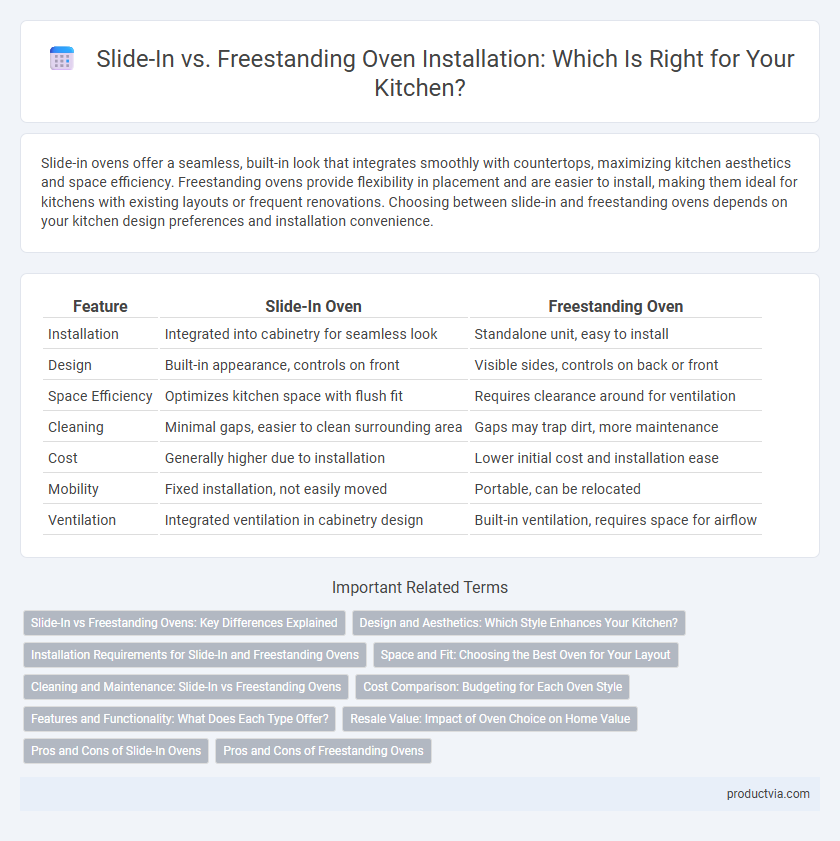Slide-in ovens offer a seamless, built-in look that integrates smoothly with countertops, maximizing kitchen aesthetics and space efficiency. Freestanding ovens provide flexibility in placement and are easier to install, making them ideal for kitchens with existing layouts or frequent renovations. Choosing between slide-in and freestanding ovens depends on your kitchen design preferences and installation convenience.
Table of Comparison
| Feature | Slide-In Oven | Freestanding Oven |
|---|---|---|
| Installation | Integrated into cabinetry for seamless look | Standalone unit, easy to install |
| Design | Built-in appearance, controls on front | Visible sides, controls on back or front |
| Space Efficiency | Optimizes kitchen space with flush fit | Requires clearance around for ventilation |
| Cleaning | Minimal gaps, easier to clean surrounding area | Gaps may trap dirt, more maintenance |
| Cost | Generally higher due to installation | Lower initial cost and installation ease |
| Mobility | Fixed installation, not easily moved | Portable, can be relocated |
| Ventilation | Integrated ventilation in cabinetry design | Built-in ventilation, requires space for airflow |
Slide-In vs Freestanding Ovens: Key Differences Explained
Slide-in ovens offer a built-in look by seamlessly integrating into cabinetry, featuring unfinished sides and a front control panel, whereas freestanding ovens stand alone with finished sides and a full back panel, allowing more flexible placement. Slide-in models typically provide a more streamlined aesthetic and easier countertop alignment, while freestanding ovens are often more versatile and simpler to install. Understanding these key differences helps homeowners choose the ideal oven type based on kitchen design and installation preferences.
Design and Aesthetics: Which Style Enhances Your Kitchen?
Slide-in ovens offer a sleek, built-in appearance that seamlessly integrates with kitchen cabinetry, creating a modern and cohesive look. Freestanding ovens feature visible sides and a backsplash, allowing for versatile placement but often standing out as a separate appliance. Choosing slide-in models enhances kitchen aesthetics by providing a flush, streamlined design that complements contemporary kitchen layouts.
Installation Requirements for Slide-In and Freestanding Ovens
Slide-in ovens require precise cabinet measurements for a seamless, built-in look, typically necessitating custom cabinetry or modifications to existing structures. Freestanding ovens offer flexible installation, as they can be placed anywhere with proper clearance and do not require built-in cabinetry. Ventilation and electrical connections must meet manufacturer specifications for both types to ensure safe operation and compliance with building codes.
Space and Fit: Choosing the Best Oven for Your Layout
Slide-in ovens offer a seamless, built-in look that maximizes kitchen space by fitting flush with cabinets, ideal for custom layouts and smaller kitchens. Freestanding ovens provide flexibility in placement, often including finished sides and backs, making them suitable for standalone use or kitchens with ample space. Selecting the right oven depends on countertop height alignment, available space, and overall kitchen design preferences to ensure optimal fit and functionality.
Cleaning and Maintenance: Slide-In vs Freestanding Ovens
Slide-in ovens offer streamlined surfaces that reduce crevices, making cleaning more efficient and minimizing dirt buildup compared to freestanding models. Freestanding ovens typically have gaps around the appliance, creating hard-to-reach areas that require extra attention during maintenance. Choosing slide-in designs can simplify daily cleaning routines and enhance overall kitchen hygiene.
Cost Comparison: Budgeting for Each Oven Style
Slide-in ovens typically cost more upfront due to their seamless integration and custom fit, ranging from $1,200 to $3,000, while freestanding ovens offer more budget-friendly options, often priced between $500 and $1,500. Installation expenses for slide-in models may be higher because of carpentry or cabinetry adjustments, whereas freestanding ovens usually require minimal setup, reducing labor costs. Homeowners should factor in total expenses including purchase price, installation, and potential kitchen modifications to optimize their oven investment.
Features and Functionality: What Does Each Type Offer?
Slide-in ovens provide a seamless, built-in appearance with controls positioned on the front, enhancing accessibility and kitchen aesthetics. Freestanding ovens offer the advantage of versatile placement due to finished sides and a back panel that houses controls, making installation simpler in various kitchen layouts. Both types deliver similar cooking functionalities, but slide-in models excel in integrated design while freestanding units prioritize convenience and flexibility.
Resale Value: Impact of Oven Choice on Home Value
Slide-in ovens offer a sleek, built-in appearance that tends to increase a home's resale value by appealing to buyers seeking modern, high-end kitchen designs. Freestanding ovens provide flexibility and easier replacement options but may not contribute as significantly to perceived home value. Real estate experts highlight that integrated appliances like slide-in ovens often make kitchens look more custom and updated, enhancing overall property appeal.
Pros and Cons of Slide-In Ovens
Slide-in ovens offer a sleek, built-in appearance that integrates seamlessly with kitchen cabinetry, enhancing overall design aesthetics. They provide easier access with controls positioned on the front, reducing the risk of reaching over hot surfaces, but installation can be more complex and costly compared to freestanding models. However, slide-in ovens often lack the versatility to be relocated easily and may require custom cabinetry adjustments, limiting future kitchen layout changes.
Pros and Cons of Freestanding Ovens
Freestanding ovens offer versatile installation options, easily fitting into various kitchen layouts without the need for built-in cabinetry, making them ideal for renters or those frequently changing kitchen designs. They typically include a cooktop and oven in one unit, simplifying setup and reducing installation costs, but their exposed sides may limit aesthetic integration with custom cabinetry. However, freestanding ovens might take up more floor space and lack the seamless, built-in appearance provided by slide-in models.
Slide-In vs Freestanding for Oven Installation Infographic

 productvia.com
productvia.com